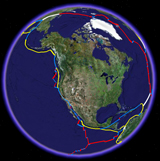

The study, "Geodetic Constraints on the 2014 M 6.0 South Napa Earthquake" published in the March/April edition of Seismological Research Letters, is the first USGS example showing that GPS and satellite readings can be used as a tool to shorten earthquake response times.Īnd while information about an earthquake's impact might be immediately known in an area such as southern California, Barnhart says the technique will be most useful in the developing world. "By having the 3D knowledge of the earthquake itself, we can make predictions of the ground shaking, without instruments to record that ground shaking, and then can make estimates of what the human and infrastructure impacts will be- in terms of both fatalities and dollars," Barnhart says. The map was made without using traditional rapid response instruments, such as seismometers, which may not afford the same level of detail for similar events around the globe. Later, USGS began offering a complementary layer of historic earthquakes, giving a continuous earthquake catalog from 1970 to the present, viewable in an interactive environment.New research from the University of Iowa, along with the United States Geological Survey (USGS), shows that GPS and satellite data can be used in a real-time, coordinated effort to fully characterize a fault line within 24 hours of an earthquake, ensuring that aid is delivered faster and more accurately than ever before.Įarth and Environmental Sciences assistant professor William Barnhart used GPS and satellite measurements from the magnitude 6.0 South Napa, California earthquake on August 24, 2014, to create a three-dimensional map of how the ground surface moved in response to the earthquake. Development continued, and UCLA professor Peter Bird's plate boundaries were added to give the earthquakes context in a global setting. In late 2004, USGS began offering a real-time earthquake layer for Keyhole Viewer (now Google Earth), one of the first applications for visualizing real-time data in a virtual globe environment. To display the earthquake locations in the Google Earth viewer, go to the layers menu, and look in the folder "Places of Interest." Open the "Geographic Features" folder, and click on "Earthquakes." The ease of finding USGS earthquake data directly within the Google Earth viewer makes complex scientific data much more accessible and understandable to more people worldwide. In the past, earthquake data for Google Earth was accessible from the USGS earthquake Web site, but users had to purposefully seek out the data feeds or stumble on them while browsing the USGS Web site. If the layer is checked, users will see a sprinkling of dots across the globe, each marking an earthquake epicenter. The new layer includes historic earthquakes since 1900, and USGS real-time earthquakes are now accessible as a hyperlink from within Google Earth. Now, it is simply a matter of toggling a check box to turn on the earthquake layer, similar to roads and other geographic features. USGS and Google signed an agreement to publish historic earthquake data from the Advanced National Seismic System (ANSS) catalog as a "built-in" layer, accessible directly from the Google Earth viewer.
#Usgs 3d earthquake globe windows
Pop-up windows in the application give the user more information about the earthquake's magnitude, date, location and depth. By viewing worldwide historic earthquake data with Google Earth mapping technology, users can quickly and easily visualize scientific information in a geographic context.Īlthough the huge databases of earthquake occurrences have been available publicly for a long time, the interactive graphic display of Google Earth makes it easy to understand the context and significance of each quake. Geological Survey (USGS) earthquake information now have an additional way to access that information.


 0 kommentar(er)
0 kommentar(er)
